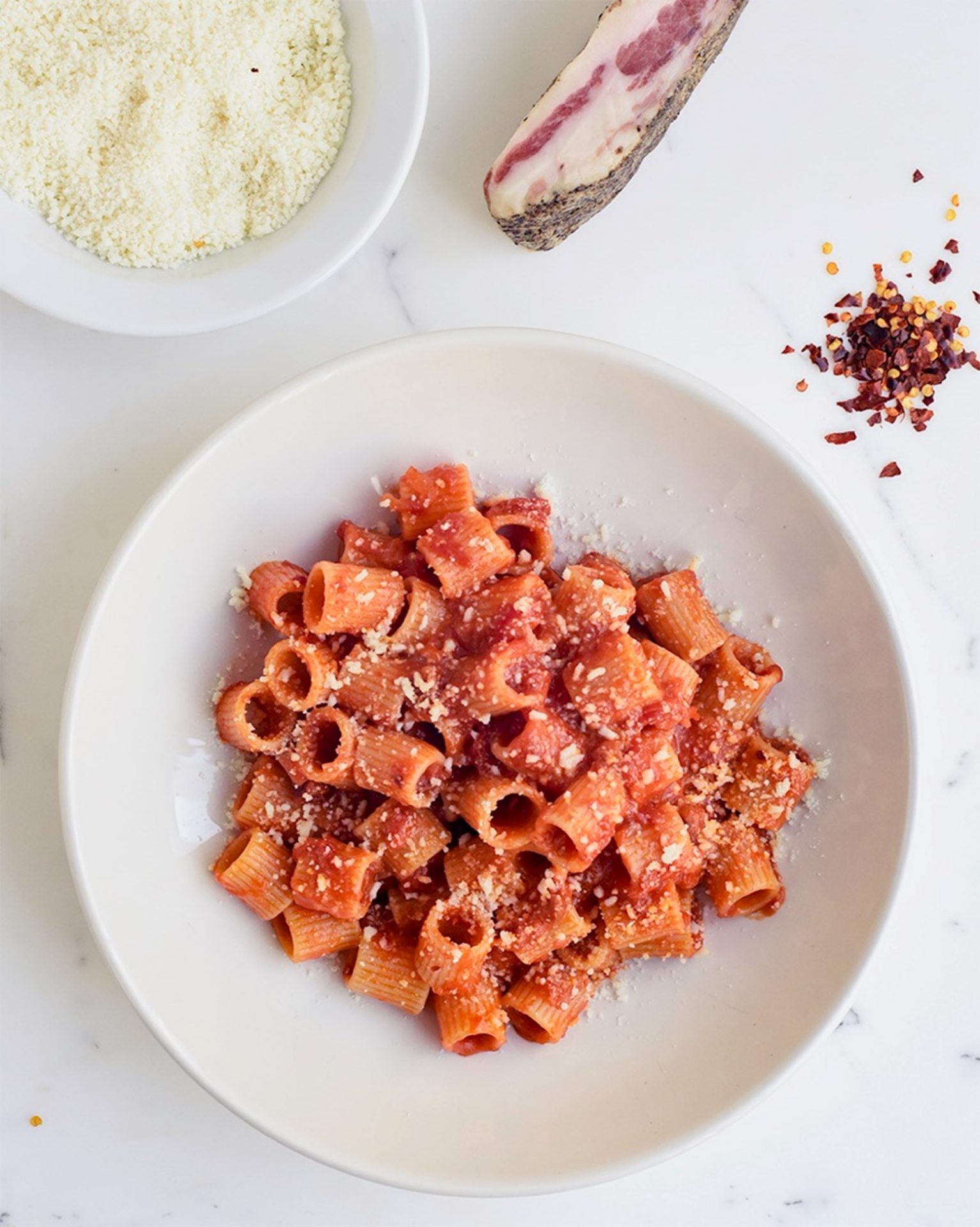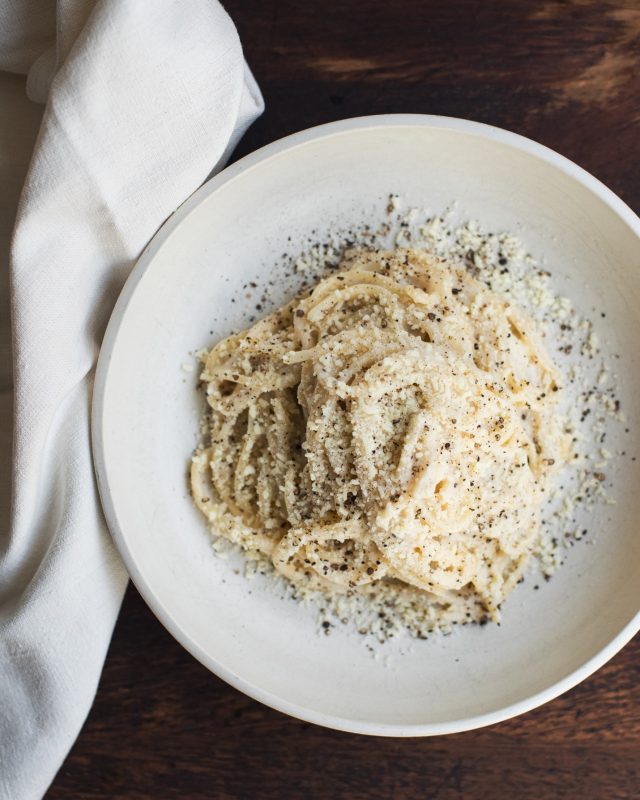Cacio e Pepe and Amatriciana: Traditional & Humble Roman Pastas

What is your death row dish? This is a question that chefs commonly ask one another. In my restaurants, the question often is “what is your death row pasta?” In other words, if your last meal on earth is a plate of pasta, what pasta dish would it be?
Generally, chefs gravitate towards dishes that are comforting and simple. Yes, there are cooks who prefer a delicate, ricotta stuffed ravioli, or fresh tagliatelle with a slow cooked ragu. The majority of respondents, however, choose one of two simple, Roman pastas: Cacio e Pepe or Amatriciana, and I couldn’t agree more. I love the combination of rich rendered guanciale fat with tomato and punchy Pecorino in Amatriciana, or Cacio e Pepe’s layered tonnarelli coated in creamy, peppery emulsified sauce. Both are traditional and humble dishes, yet they seem to be more memorable than many, more complex dishes .
Cacio e pepe, literally translated, means cheese and pepper. The dish consists of 3 ingredients: Pecorino Romano cheese, black pepper and pasta (traditionally tonnarelli, which are long egg noodles, similar to spaghetti). The origins of Cacio e Pepe are not clear. One theory dates back centuries to when the dish was a staple for Roman shepherds who would graze their sheep through the Apennine Mountains during the spring and summer months. Black pepper, which was unaffordable for most, likely was not included in the early versions of Cacio e Pepe. Dried pasta, however, was inexpensive, lightweight, and resistant to spoilage. Shepherds would boil pasta, mix the cheese (produced by the milk of his flock) with a splash of the starchy cooking water and toss it all together, producing a rich, creamy sauce. The other theory, which is believed by most Romans, is that Cacio e Pepe, along with Carbonara and many other Roman dishes, developed within a culture of frugality, in low income homes near the factories and mines surrounding the outskirts of Rome during the 19th and early 20th century.
Amatriciana sauce, called Matriciana by the Romans, is named after the small Lazio town of Amatrice, which is located near the border with Abruzzo. The sauce is made with five ingredients: guanciale (salt cured pork jowl), tomatoes, Pecorino Romano, chili and pasta. Amatriciana evolved from Pasta alla Gricia, an ancient Roman dish that still is served in the majority of Roman trattorias. Gricia sauce, the name of which refers to “Gricio” (vendors of common foods), dates back to the fourth century, long before the introduction of tomatoes to Italy. Gricia is made from guanciale, Pecorino Romano and black pepper. The story is that during the nineteenth century, when the Bourbon kings conquered the area, the recipe for Pasta alla Gricia was “corrected” with the addition of tomatoes which became Pasta all’Amatriciana.
Regardless of the history, Cacio e Pepe and Amatriciana are delicious pastas. They are dishes that maintain a protected restraint from change by the Romans. A discussion amongst Romans about adding chili to Cacio e Pepe or garlic to Amatriciana would likely result in uproar. Romans, and Italians more generally, have a unified pride in their culinary traditions. I love that they are dedicated to the preservation of their recipes.
I find that deceivingly simple dishes such as Cacio e Pepe and Amatriciana are sometimes perceived as easy to make. This could not be further from the truth. Working with minimal ingredients leaves little to no room for error. French chefs ask applicants to make a classic omelette, which demonstrates technique and instinct using only two ingredients. The same principle applies to simple pastas.
When in Rome, I always ask taxi drivers where I can find the best Cacio e Pepe. The answer is always different, and so are the pastas. Generally, all cooks in Rome use the same ingredients for Cacio e Pepe, but the methods can differ, often minutely. This results in diverse outcomes and can take the dish from good to great. Differences can be in the temperature of grated Pecorino, where the black pepper is from and whether it was toasted, the cut and protein levels of the pasta, and starchiness of the water. These are only a few factors that can differ from chef to chef. As the majority of Roman trattorias have the classics pasta dishes on their menus, these details produce an incredibly competitive playing field for the execution of these dishes.
So, why is it that these are common death row pastas? For myself, it is not solely the flavour and texture, it is the entire culture and history that permeates them. They are simple dishes composed of a limited number of frugal yet quality ingredients. As a chef, I am inspired by these traditional recipes and love to play with their flavours to create something different. The truth, however, is that nothing needs to be added and nothing needs to be removed: they are balanced and perfect as is. Each would be a perfect final meal.
Cacio e Pepe

Cacio e Pepe may be simple but it can be quite temperamental and can split or seize if not done correctly. It is important that you work quickly when pulling the pasta from the cooking water to the bowl of Cacio e Pepe. Although it is not traditional, butter is becoming more common amongst Roman chefs as it gives an extra layer of sheen and creaminess. If you find Pecorino Romano too strong or salty for your taste you can cut it with 50% Grana Padano.
Serves 2
Ingredients:
250 grams of tonnarelli or spaghetti
¾ cup of grated Pecorino Romano at room temperature, plus more for topping
1 tablespoon of black peppercorns
1 small knob of unsalted butter (optional)
Procedure:
- Using a mortar and pestle, coarsely grind the peppercorns. Roast the ground peppercorns over medium-high heat until fragrant, approximately 1 minute. Immediately place the peppercorns in a bowl in order to stop the roasting process.
- Cook the pasta in a large pot of very lightly salted, boiling water until al dente.
- While the pasta is cooking, place the Pecorino and butter in a medium sized mixing bowl along with 1 teaspoon of the crushed, roasted peppercorns. Once the pasta is ¾ cooked, slowly add 1 ounce of the pasta cooking water into the bowl of pecorino, mixing well with the back of a wooden spoon. Repeat this process with an additional ounce of the cooking water. Mix into a smooth paste.
- Using tongs, pull the pasta directly from the cooking water into the bowl of cacio e pepe sauce. Stir vigorously with a wooden spoon, add an additional ½ – 1 ounce of the pasta cooking water and continue to mix until the sauce is creamy and pasta is coated. If the sauce is too dry, add a splash more cooking water. Serve immediately in warmed plates topped with more pecorino and roasted black pepper.
Mezze Maniche All’ Amatriciana

There are two variations for Amatriciana sauce, with or without onion. I go back and forth, however, the onion adds a layer of sweetness that works beautifully with the rich guanciale and pecorino.
Serves 4
Ingredients:
500 grams of mezze maniche
250 grams of guanciale or Pancetta
¾ cup of grated pecorino Romano
1 tablespoon of chili flakes
1 teaspoon of kosher salt
1 tablespoon of Olive Oil
1 shallot, thinly sliced (optional)
1 796ml can of San Marzano tomatoes, crushed by hand
Procedure:
- Bring a large pot of lightly salted water to the boil.
- Using a sharp knife, trim and discard a thin amount of the outer layer of the guanciale which can have a rancid flavour. Cut the trimmed guanciale into medium sized cubes.
- Heat a large frying pan over medium heat, add the guanciale and olive oil, cook until rendered and dark golden. Remove the guanciale from the pan, reserving it for later. Add the shallots to the pan, cook until softened. Add the crushed tomatoes, chili flakes and salt, increase the heat to medium-high. Cook the sauce for 10 – 15 minutes or until the guanciale fat has risen to the top of the sauce, stir frequently while cooking.
- While the tomato sauce is cooking, cook the mezze maniche until just under al dente. Once the pasta is cooked, pull it directly from the cooking water to the simmering sauce with a slotted spoon. Return the pan to high heat, add ½ a cup of the pasta cooking water and cook for about 1 minute or until the sauce has thickened and is coating the pasta. Remove the pan from the heat. Stir in the guanciale and pecorino. Serve immediately topped with a little more pecorino.
Chef Daniel Costa is the chef/owner of Corso32, Bar Bricco and Uccellino.
Read other articles by Daniel Costa in this series:
Stale Bread & Italian Cuisine: Necessity is the Mother of Invention with Zuppa di Pane recipe
